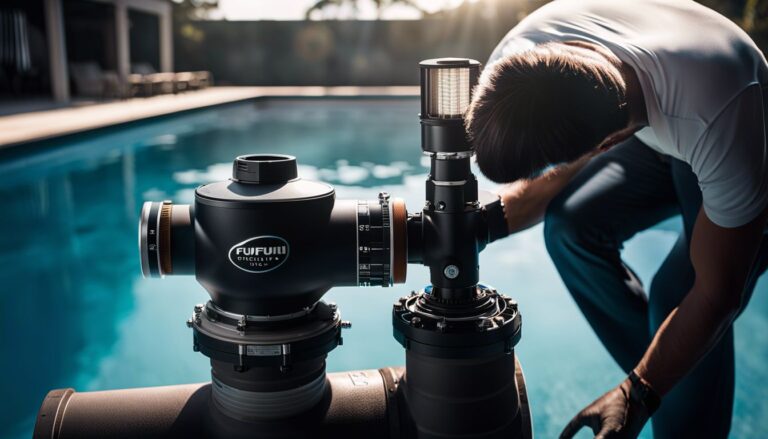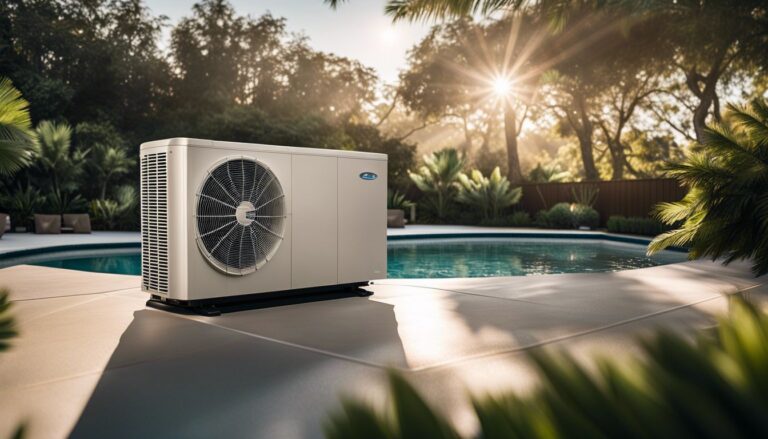How Does Robotic Pool Cleaner Work? Robot Guide 2023
How Does Robotic Pool Cleaner Work?
How robotic pool cleaners work: If you own a swimming pool, you know how challenging it can be to keep it clean and sparkling.
Enter robotic pool cleaners, the solution to all your pool maintenance woes. After owning one from when we built our pool, we wouldn’t own one without a robotic cleaner!
These cleaners are designed to navigate your entire pool and clean it thoroughly and efficiently without any additional effort.
Understanding Robotic Pool Cleaners
Robotic pool cleaners are becoming increasingly popular among pool owners due to their efficiency and ease of use. There are two main types of robotic pool cleaners: robot and suction cleaners.
Robot cleaners are autonomous machines that navigate the entire pool surface and use brushes and scrubbers to clean the pool. On the other hand, suction cleaners attach to the pool’s filtration system and move along the bottom and walls of the pool, using suction to collect debris.
Choosing a cleaner that effectively covers the entire pool area is crucial to maintaining a clean swimming environment. Robot cleaners are often recommended for larger pools and those with more complex shapes, as they are better equipped to navigate the entire area.

Key Components of a Robotic Pool Cleaner
Robotic pool cleaners come equipped with several key components for efficient and thorough cleaning. Understanding these components can help you choose the right robotic pool cleaner for your specific pool cleaning needs.
One of the most important components of a robotic pool cleaner is the booster pump. This pump is designed to increase water pressure, allowing the cleaner to collect debris and efficiently clean the pool floor. Suction cleaners, on the other hand, attach to your pool’s filtration system and use the power of the pool pump to operate.
| Component | Role |
|---|---|
| Booster Pump | Increase water pressure for efficient cleaning |
| Suction Cleaners | Attach to pool’s filtration system to operate |
| Filter Bag | Collect and trap debris for easy disposal |
Another key component is the filter bag. This bag collects and traps debris, ensuring it doesn’t circulate back into your pool. Choosing a filter bag that is easy to clean and replace is important, as this will save you time and effort in the long run.
Best Robotic Pool Cleaner
Overall, the key components of a robotic pool cleaner work together seamlessly to provide a clean and clear pool for you and your family to enjoy. Whether you opt for a booster pump or a suction cleaner, select a model best suited for your pool’s cleaning needs.

How Does Robotic Pool Cleaner Work?
A robotic pool cleaner is a sophisticated machine that uses advanced technology to keep your pool clean. They have various features that make them convenient and easy to use. This section will explore some key aspects of a robotic pool cleaner’s operation and how they work.
The Functionality of the Robot Cleaner
The robot cleaner is the heart of a robotic pool cleaner. It is responsible for moving around the pool and collecting debris. It has powerful motors that drive the cleaner’s movement and a collection of brushes that help it scrub the pool surfaces.
The robot cleaner removes your pool’s dirt, debris, and algae. It operates independently, using a combination of sensors and artificial intelligence algorithms to navigate around the pool. Most robotic pool cleaners have remote control capability, allowing you to control it from a distance.
Pool Filter Integration
A robotic pool cleaner operates independently from your pool’s filtration system. However, it still works with the existing pool filter to ensure optimal cleaning. The cleaner’s filter bag helps to capture debris, preventing it from entering the pool’s filtration system. This ensures that the pool’s filtration system remains unclogged, which saves time and money in maintenance.
Remote Control Capabilities
Most robotic pool cleaners come with remote control capabilities, allowing you to guide the cleaner to specific areas of the pool. This feature lets you target problems such as tight corners, specific pool surfaces, and steps. The remote control makes turning the cleaner on and off easy, set the cleaning cycle duration, and adjust other settings.

How Does Robotic Pool Cleaner Work: Cleaning Functionality
A robotic pool cleaner works by collecting debris and dirt in its filter bag, leaving your pool sparkling clean. It operates using an electric motor, which provides the power needed to run the cleaner’s various components. The cleaner moves around the pool surface using a combination of wheels and underwater fins.
Robotic cleaners are designed to clean the entire pool surface, including the walls and floor, in hours. This saves pool owners time and effort and ensures the pool is always clean and ready for use.
In summary, a robotic pool cleaner uses advanced technology, powerful motors, and sensors to move around your pool and clean all surfaces. They are convenient and easy to use, with remote control capabilities, pool filter integration, and effective cleaning functionality.
The Cleaning Cycle of a Robotic Pool Cleaner
Robotic pool cleaners operate on a cleaning cycle, which refers to the time it takes for the cleaner to navigate the entire pool and clean its surface. The cleaning cycle typically ranges from 1.5 to 3 hours, depending on the pool size and the cleaner’s model.
During the cleaning cycle, the robotic pool cleaner uses brushes and suction power to remove dirt, debris, and other impurities from the pool’s surfaces. The cleaner moves around the pool using its wheels and tracks, covering the floor, walls, and waterline.
Robotic pool cleaners are designed to work independently of the pool’s filtration system, using their filters to trap and collect debris. This ensures the pool water remains clean and clear without adding extra strain on the pool’s filter system.
Placing the cleaner in the pool at the right time is important to ensure the most efficient cleaning cycle. For example, if the pool is still experiencing a lot of movement from swimmers, it may be best to wait until the pool is calm before starting the cleaning cycle.

Pressure-Side Cleaners
Pressure-side cleaners operate on a different cleaning cycle compared to robotic pool cleaners. These cleaners use the pool’s filtration system to boost their cleaning power. As the cleaner moves around the pool, it collects debris and sends it to the pool’s filter system through a separate hose. The cleaner’s cleaning cycle depends on the pool’s filtration system, which means the cleaner can only operate when the pool’s filter pump is running.
Pressure-side cleaners typically have a shorter cleaning cycle than robotic pool cleaners, ranging from 30 minutes to an hour. These cleaners effectively remove larger debris from the pool floor, such as leaves, twigs, and rocks. However, they are less effective in cleaning pool walls and waterlines.
Cleaning Different Pool Surfaces
Robotic pool cleaners are equipped to clean various pool surfaces, including walls, and choosing the right type of cleaner is essential to match the pool surface. Suction-side pool cleaners are best suited for flat surfaces, while pressure-side pool cleaners are suitable for pools with walls or other obstacles.

Suction-side pool cleaners rely on a pool pump to create suction that draws in debris, effectively cleaning the pool floor. They move randomly, covering the entire pool surface and collecting debris. However, they are not ideal for pools with walls, steps, or narrow spaces, as they can get stuck and cause damage to the pool surface.
Alternatively, pressure-side cleaners use the water pressure from the pool pump to move around the pool and collect debris. They can climb walls and other obstacles, making them ideal for pools with stairs or other features. They have their filter bag, which prevents clogging in the pool’s filtration system.
Whatever type of cleaner you choose, ensure that the cleaner is the best to match the pool surface for optimal cleaning results.
Maintaining a Clean and Clear Pool
As a pool owner, keeping the water clean and debris-free is essential for maintaining a healthy swimming environment. Fortunately, robotic pool cleaners offer an excellent solution for achieving and maintaining a pristine pool.
One of the main benefits of using a robotic pool cleaner is that it provides clean water for swimming. The cleaner’s electric motor ensures thorough pool cleaning, leaving the water crystal clear and inviting. The result is a more enjoyable swimming experience for everyone.

Using a robotic pool cleaner also helps reduce the time and effort required for pool maintenance. The cleaner effectively cleans the pool floor, walls, and waterline, eliminating the need for manual scrubbing and brushing. The cleaner’s filter system also traps and collects debris, preventing it from clogging the pool’s filtration system. This results in a long-lasting filter system and extended equipment lifespan.
Whether you are a busy homeowner or simply looking for an easy solution to maintain your pool’s cleanliness, a robotic pool cleaner is an excellent investment. Its efficient electric motor and thorough cleaning abilities ensure a clean and clear pool that is safe for swimming.
Integration with the Pool’s Filtration System
Robotic pool cleaners are designed to work with the pool’s filtration system, providing an efficient cleaning solution for in-ground pools. Pressure-side pool cleaners use the pool’s water pressure to move around, clean, and scrub the surfaces.
They collect debris into a filter bag, reducing the load pumped into the pool’s filter system. Ultimately, this integration reduces wear and tear on the filter system, resulting in lower energy consumption and cost savings.
As the pressure-side pool cleaner operates, it also creates a vortex effect, mixing the pool water and helping to regulate the chemicals. While robotic pool cleaners can be more expensive than other options, such as suction side cleaners, their integration with the pool’s filtration system brings many benefits. Pool owners can enjoy a cleaner pool with less maintenance in the long run.

When deciding on the best robotic pool cleaner for your pool, it’s crucial to consider the integration aspect. Not all robotic pool cleaners are created equal, and some may not be compatible with certain filtration systems.
Integrating robotic pool cleaners with the pool’s filtration system provides an efficient cleaning solution that saves time, energy, and money. With this integration, pool owners can enjoy a clean and clear pool with a reduced need for maintenance, ultimately allowing more time to enjoy a refreshing swim.
Handling Large Debris
One of the advantages of robotic pool cleaners is their ability to handle large debris effectively. When leaves and other debris fall into the pool, removing them with standard pool cleaning equipment can be challenging. Robotic pool cleaners use suction power to trap and collect large debris in their filter bag, ensuring the pool water remains clean.
Choosing a robotic pool cleaner with a reliable filter bag is essential to handle large debris effectively. The filter bag should be easy to remove and clean, allowing quick and easy maintenance.
In addition, a reliable power supply is crucial in handling large debris. Robotic pool cleaners require a certain amount of power to function correctly, and a weak power supply can result in reduced suction power, making it challenging to remove large debris effectively.
| Tip: | Consider purchasing a robotic pool cleaner with a large filter bag capacity and a powerful motor to handle large debris more efficiently. |
|---|
With a robotic pool cleaner, pool owners can enjoy a clean and clear pool, even when large debris falls into the water.

Cleaning the Bottom of Your Pool
Cleaning the bottom of your pool is an essential aspect of pool maintenance. Robotic pool cleaners are efficient and convenient for keeping your pool floor clean. Pressure pool cleaners are particularly effective in cleaning the bottom of your pool.
Pressure pool cleaners use water pressure to move around the pool and collect debris. They are designed to work alongside the pool’s filter system to ensure thorough cleaning of the pool bottom. When choosing a pressure pool cleaner, ensuring it is compatible with your pool’s filtration system is important.
During cleaning, the pressure pool cleaner pushes water across the pool bottom, dislodging dirt and debris. The water is then directed towards the filter system, which goes through a filtration process to trap and remove the debris before it is released back into the pool.
One advantage of using a pressure pool cleaner is that it can effectively remove debris from hard-to-reach areas, including corners and steps. This ensures that every inch of the pool bottom is thoroughly cleaned. It is also an effective option for pools with uneven surfaces.
A pressure pool cleaner typically comes with a bag or canister for collecting debris. Choosing a pool cleaner with a large enough bag or canister for your pool size is important to ensure it can collect all debris in one cleaning cycle.

Additional Considerations for Pool Owners
When it comes to choosing the best robotic pool cleaner, there are a few additional considerations that pool owners should keep in mind:
- If your pool has a lot of large leaves, you may want to consider a cleaner with a larger filter bag that can handle the debris without needing to be emptied too often.
- Don’t forget to clean the waterline of your pool. Many robotic pool cleaners are designed to clean the floor and walls of the pool, but not the waterline. You may need to do this manually or choose a cleaner designed for this task.
- You’ll need a cleaner that is up to the task if you have a large pool. Look for models designed to cover more ground and have longer cleaning cycles.
- Pressure side cleaners are a great option for pools that have larger debris that needs to be removed. These cleaners use water pressure to move debris toward the filter system and out of the pool.
Considering these factors, you can choose the best robotic pool cleaner for your specific needs. Remember, a little research can go a long way toward ensuring you have a clean and clear pool all season long.

FAQ – How Does a Robotic Pool Cleaner Work?
Here are some frequently asked questions about how robotic pool cleaners work:
How do robotic pool cleaners navigate around the pool?
Robotic pool cleaners use built-in sensors and sophisticated algorithms to navigate around the pool. These intelligent devices are designed to climb the pool walls, traverse steps, and avoid obstacles. The sensors help the device understand the shape and size of your pool, while the computer chip runs algorithms to determine the most efficient cleaning path, regardless of your pool shape.
How do robotic pool cleaners clean the pool?
Robotic pool cleaners utilize various mechanisms like brushes, suction, and water jets to provide a thorough cleaning. Dual scrubbing brushes dislodge stubborn dirt from the pool’s surface. The suction then collects the dislodged debris, small or large, into a filter bag or cartridge. Some advanced models can handle small leaves, or bigger debris like large leaves and twigs, ensuring a clean pool.
Can a robotic pool cleaner clean the waterline?
Yes, some of the best automatic pool cleaners can scrub and clean the water line, which can be challenging even for manual pool cleaners. They use brushes and water jets to dislodge and remove any dirt or grime present, maintaining a sparkling waterline.
How long does a robotic pool cleaner take to clean a pool?
The cleaning cycle of a robotic pool cleaner depends on the size of your pool and the specific model of the cleaner. Some cleaners have shorter cycle times and can clean smaller pools within a few hours, while larger pools may require a more extended cycle.
Do robotic pool cleaners work with all types of pools?
Robotic pool cleaners are versatile and work with various pools, including in-ground and above-ground pools. However, it’s crucial to ensure the cleaner is compatible with your specific pool type and size for the best results.
Can a robotic pool cleaner handle large debris?
Indeed, certain robot pool cleaners are designed to handle larger debris like leaves and twigs. It’s important to regularly empty and clean the filter bag or cartridge to prevent clogging and maintain optimal performance.
How often should I use my robotic pool cleaner?
Using your robotic pool cleaner regularly is recommended, ideally once a week. This ensures that your pool remains clean and clear throughout the season, preventing the build-up of stubborn dirt.
Do I need additional equipment for a robotic pool cleaner?
Most robotic pool cleaners come as a complete package, ready to be deployed into your pool. Some models may require an additional booster pump, which will be specified in the product description.
How much power does a robotic pool cleaner use?
Robotic pool cleaners are designed to be energy-efficient. While power consumption varies by model, most use low-voltage power supplies and consume less power than other pool cleaners, such as pressure or suction pool cleaners.
Can I use a robotic pool cleaner with a saltwater pool?
Most robotic pool cleaners are safe to use with saltwater pools. Make sure to choose a model designed for use with saltwater to ensure optimal performance and longevity.
In summary, robotic pool cleaners are a convenient and efficient solution for maintaining a clean pool. They save much time and energy by automating what can be daunting, freeing you to enjoy your pool.
Whether you’re considering a Dolphin Nautilus or Premier for its smartphone app features or a Kreepy Krauly for its proven performance, the most important step is to choose the best cleaner for your specific needs and pool type.








